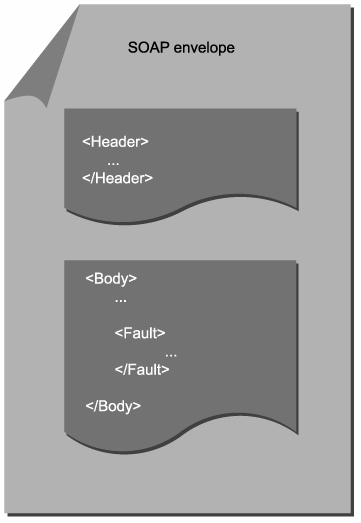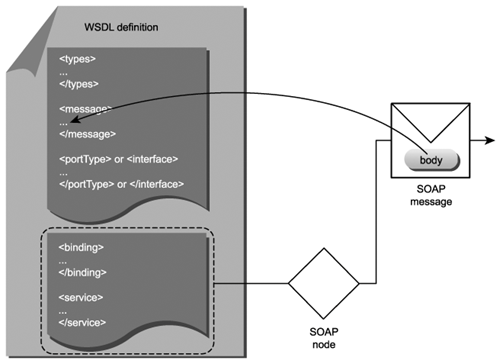SOAP language basics
In the previous section we established that a WSDL definition intentionally separates abstract from concrete definition details. One of the benefits of doing so is that we can isolate communication protocols that implement the messaging required by a service from the implementation-neutral service interface. However, given that SOAP has become the messaging format of choice for SOA, we will very likely be binding our abstract interfaces to SOAP.
Within the service-oriented design process, we place a great deal of emphasis on hand crafting the WSDL definition, along with required XSD schema types. SOAP messages generally do not require as much hands on attention. We spend more time working with SOAP syntax in Chapter 17, where we explore WS-* extensions that are implemented via SOAP headers. Still, this is as good of a time as any to introduce some basic parts of the SOAP language.
As we established in Chapter 5, the structure of SOAP messages is relatively simple. They consist of header, body, and fault sections, all encased in an envelope. Appropriately, the elements we describe in this section (Figure 13.5) are represented by the same names. (The manner in which SOA affects the utilization of SOAP is explored in the SOAP and SOA section in Chapter 14.)
Figure 13.6. The structure of a SOAP message document.

13.4.1. The Envelope element
The Envelope element represents the root of SOAP message structures. It contains a mandatory Body construct and an optional Header construct.
Example 13.18. The root Envelope construct hosting Header and Body constructs.
<Envelope xmlns ="http://schemas.xmlsoap.org/soap/envelope/">
...
...
Envelope>
13.4.2. The Header element
As explained in Chapter 5, the header portion of the SOAP message has become a key enabler of the feature set provided by WS-* specifications. Most of these extensions are implemented on a message level and introduce new standardized SOAP header blocks destined to be embedded in the Header construct.
Example 13.19. The Header construct hosting a header block.
<Header> 0131858580-JDJ903KD Header>
Header blocks also can be customized, as shown in Example 13.19, where the SOAP header is used to host a unique CorrelationID element. The mustUnderstand attribute indicates that the contents of the header must be understood by any receiver of the message that is required to process this header. If the mustUnderstand value is set to "0" the processing of this header becomes optional.
13.4.3. The Body element
This is the one required child element of the SOAP Envelope construct. It contains the message payload formatted as well-formed XML. The structure and naming used to define this part of the SOAP message relates to the style and use attributes discussed in the previous WSDL binding element description.
SOAP message Body constructs are defined within the WSDL message constructs which, as we've already established, reference XSD schema data type information from the WSDL types construct (Figure 13.7).
Figure 13.7. A SOAP message body defined within the WSDL message construct. The actual processing of the SOAP message via a wire protocol is governed by the constructs within the concrete definition.

Example 13.20. The contents of a sample Body construct.
<Body> 0131858580 Service-Oriented Architecture Concepts, Technology, and Design Body>
While SOAP header blocks can be processed actively during the transmission of a SOAP message, the SOAP body should not be touched. However, if allowed, intermediary services can still read and derive information from body content. For example, a correlation identifier used in a SOAP header can be generated based on the ISBN value shown in the preceding example.
13.4.4. The Fault element
The optional Fault construct provides a ready made error response that is added inside the Body construct. In the example that follows, this fault information is further sub-divided using additional child elements. The faultcode element contains one of a set of fault conditions predefined by the SOAP specification. Both the faultstring and detail elements provide human readable error messages, the latter of which can host an entire XML fragment containing further partitioned error details.
Example 13.21. The Fault construct residing within the Body construct.
<Fault> MustUnderstand header was not recognized The CorrelationID header was not processed by a recipient that was required to process it. Now a fault's been raised and it looks like this recipient is going to be a problem. Fault>
In our example a Fault construct is provided to respond to a MustUnderstand violation that may occur when a service expected to process the message correlation identifier fails to do so.
|
SUMMARY OF KEY POINTS |
|---|
|
Introduction
- Why this book is important
- Objectives of this book
- Who this book is for
- What this book does not cover
- How this book is organized
- Additional information
Case Studies
- Case Studies
- How case studies are used
- Case #1 background: RailCo Ltd.
- Case #2 background: Transit Line Systems Inc.
Part I: SOA and Web Services Fundamentals
Introducing SOA
- Introducing SOA
- Fundamental SOA
- Common characteristics of contemporary SOA
- Common misperceptions about SOA
- Common tangible benefits of SOA
- Common pitfalls of adopting SOA
The Evolution of SOA
- The Evolution of SOA
- An SOA timeline (from XML to Web services to SOA)
- The continuing evolution of SOA (standards organizations and contributing vendors)
- The roots of SOA (comparing SOA to past architectures)
Web Services and Primitive SOA
- Web Services and Primitive SOA
- The Web services framework
- Services (as Web services)
- Service descriptions (with WSDL)
- Messaging (with SOAP)
Part II: SOA and WS-* Extensions
Web Services and Contemporary SOA (Part I: Activity Management and Composition)
- Web Services and Contemporary SOA (Part I: Activity Management and Composition)
- Message exchange patterns
- Service activity
- Coordination
- Atomic transactions
- Business activities
- Orchestration
- Choreography
Web Services and Contemporary SOA (Part II: Advanced Messaging, Metadata, and Security)
- Web Services and Contemporary SOA (Part II: Advanced Messaging, Metadata, and Security)
- Addressing
- Reliable messaging
- Correlation
- Policies
- Metadata exchange
- Security
- Notification and eventing
Part III: SOA and Service-Orientation
Principles of Service-Orientation
- Principles of Service-Orientation
- Service-orientation and the enterprise
- Anatomy of a service-oriented architecture
- Common principles of service-orientation
- How service-orientation principles inter-relate
- Service-orientation and object-orientation (Part II)
- Native Web service support for service-orientation principles
Service Layers
- Service Layers
- Service-orientation and contemporary SOA
- Service layer abstraction
- Application service layer
- Business service layer
- Orchestration service layer
- Agnostic services
- Service layer configuration scenarios
Part IV: Building SOA (Planning and Analysis)
SOA Delivery Strategies
- SOA Delivery Strategies
- SOA delivery lifecycle phases
- The top-down strategy
- The bottom-up strategy
- The agile strategy
Service-Oriented Analysis (Part I: Introduction)
- Service-Oriented Analysis (Part I: Introduction)
- Service-oriented architecture vs. Service-oriented environment
- Introduction to service-oriented analysis
- Benefits of a business-centric SOA
- Deriving business services
Service-Oriented Analysis (Part II: Service Modeling)
- Service-Oriented Analysis (Part II: Service Modeling)
- Service modeling (a step-by-step process)
- Service modeling guidelines
- Classifying service model logic
- Contrasting service modeling approaches (an example)
Part V: Building SOA (Technology and Design)
Service-Oriented Design (Part I: Introduction)
- Service-Oriented Design (Part I: Introduction)
- Introduction to service-oriented design
- WSDL-related XML Schema language basics
- WSDL language basics
- SOAP language basics
- Service interface design tools
Service-Oriented Design (Part II: SOA Composition Guidelines)
- Service-Oriented Design (Part II: SOA Composition Guidelines)
- Steps to composing SOA
- Considerations for choosing service layers
- Considerations for positioning core SOA standards
- Considerations for choosing SOA extensions
Service-Oriented Design (Part III: Service Design)
- Service-Oriented Design (Part III: Service Design)
- Service design overview
- Entity-centric business service design (a step-by-step process)
- Application service design (a step-by-step process)
- Task-centric business service design (a step-by-step process)
- Service design guidelines
Service-Oriented Design (Part IV: Business Process Design)
- Service-Oriented Design (Part IV: Business Process Design)
- WS-BPEL language basics
- WS-Coordination overview
- Service-oriented business process design (a step-by-step process)
Fundamental WS-* Extensions
- Fundamental WS-* Extensions
- You mustUnderstand this
- WS-Addressing language basics
- WS-ReliableMessaging language basics
- WS-Policy language basics
- WS-MetadataExchange language basics
- WS-Security language basics
SOA Platforms
Appendix A. Case Studies: Conclusion
EAN: 2147483647
Pages: 150
